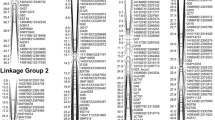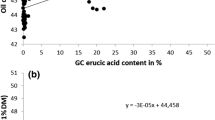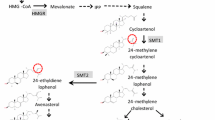Abstract
A detailed RFLP-genomic map was used to study the genetics of oil, seed and meal protein and sum of oil and seed/meal protein contents in a recombinant doubled-haploid population developed by crossing black- and yellow-seeded Brassica juncea lines. Two yellow seed color genes (SC-B4, SC-A6) and one QTL for erucic acid content (E1b) showed pleiotropic effect for oil, protein and sum of oil and seed/meal protein contents. Six (O-A1, O-A6, O-A9, O-B3, O-B4, O-B5) and five (SP-A1, SP-A9, SP-B4, SP-B6, SP-C) QTLs were significant for oil and seed protein contents, respectively. Tight linkage of three of these QTLs (SP-A1, SP-A9, SP-B4, O-A1, O-A9, O-B4), with opposite effects, poses challenge to the plant breeders for simultaneous improvement of negatively correlated (r = −0.7**) oil and seed protein contents. However, one QTL for oil content (O-B3) and two for seed protein content (SP-B6, SP-C) were found to be unlinked, which offer the possibility for simultaneous improvement of these two traits. QTLs significant for meal protein (MP-A1, MP-A6, MP-A9, MP-B5, MP-B6) were significant at least for oil, seed protein or sum of oil and seed/meal protein contents (T-A6, T-A7, T-B4, T-B5). Sum of oil and seed protein contents and sum of oil and meal protein contents had a perfect correlation, as well as same epistatic interactions and QTLs with similar additive effect. This indicates that protein in seed or meal has practically the same meaning for breeding purposes. Epistatic interactions were significant for the quality traits, and their linkage reflected association among the traits.


Similar content being viewed by others
References
Burton W, Salisbury P, Potts D (2003) The potential of canola quality Brassica juncea as an oilseed crop for Australia. In: Proceeding of the 11th international rapeseed congress, vol 1. Copenhagen, pp 5–7
Butruille DV, Guries RP, Osborn TC (1999) Linkage analysis of molecular markers and quantitative trait loci in populations of inbred backcross lines of Brassica napus L. Genetics 153:949–964
Cheung WY, Landry BS (1998) Molecular mapping of seed quality traits in Brassica juncea L. Czern. and Coss. Acta Hortic 459:139–147
Daun JK, Clear KM, Williams P (1994) Canadian grain commission, Grain Research Lab, Winnipeg, Manitoba, R3C 3G8. JAOCS 71:10
Dawn JK, DeClercq DR (1988) Quality of yellow and dark seeds in Brassica compestris canola varieties of Candle and Tobin. JACCS 65:122–126
Downey RK (1990) Brassica oilseed breeding-acheivements and opportunities. Plant Breed Absct 60:1165–1170
Ecke W, Uzunova M, Weißleder K (1995) Mapping the genome of rapeseed (Brassica napus L.). II. Localization of genes controlling erucic acid synthesis and seed oil content. Theor Appl Genet 91:972–977
Grami B, Stefansson BR (1977a) Gene action for protein and oil content in summer rape. Can J Plant Sci 57:625–631
Grami B, Stefansson BR (1977b) Genetics of protein and oil content in summer rape: Heritability, numbers of effective factors, and correlations. Can J Plant Sci 57:937–943
Jansen RC, Stam P (1994) High resolution of quantitative traits into multiple trait via interval mapping. Genetics 136:1447–1455
Jönsson R, Bengtsson R (1970) Yellow-seeded rape and turnip rape. I. Influence of breeding for yellow seeds upon yield and quality parameters. Sver Utsadesforen Tidskr 80:149–155
Krzymanski J (1998) Agronomy of oilseed Brassicas. Acta Hortic 459:55–60
Li Z, Pinson SRM, Park WD, Paterson AH, Stansel JW (1997) Epistasis for three grain yield components in rice (Oryza sativa L.). Genetics 145:453–465
Mahmood T, Ekuere U, Yeh F, Good AG, Stringam GR (2003a) RFLP linkage analysis and mapping genes controlling the fatty acid profile of Brassica juncea using reciprocal DH populations. Theor Appl Genet 107:283–290
Mahmood T, Ekuere U, Yeh F, Good AG, Stringam GR (2003b) Molecular mapping of seed aliphatic glucosinolates in Brassica juncea. Genome 46:753–760
Mahmood T, Rahman MH, Stringam GR, Raney JP, Good AG (2005a) Molecular markers for seed color in Brassica juncea. Genome 48:755–760
Mahmood T, Rahman MH, Stringam GR, Yeh F, Good AG (2005b) Molecular markers for yield components in Brassica juncea—do these assist in breeding for high seed yield? Euphytica 144:157–167
Newkirk RW, Classen HL, Tyler RT (1997) Nutritional evaluation of low glucosinolate mustard meals (Brassica juncea) in broiler diets. Poult Sci 76:1272–1277
Rahman MH, Joersbo M, Poulson MH (2001) Development of yellow-seeded Brassica napus of double low quality. Plant Breed 120:473–478
Rakow G (2003) The potential of Brassica juncea, B. carinata and Sinapis alba as new oilseed crops in Canada. In: Proceeding of the 11th international rapeseed congress, vol 1, Copenhagen, p1
SAS Institute Inc. (1989) SAS/STAT. Cary, NC, USA
Si P, Mailer JM, Galwey N, Turner DW (2003) Influence of genotype and environment on oil and protein concentrations of Canola (Brassica napus L.) grown across southern Australia. Aust J Agric Res 54:397–407
Snap JW, Wright AJ, Simpson E (1984) Methods for estimating genes number for quantitative character using doubled haploid lines. Theor Appl Genet 67:143–149
Thiagarajah MR, Stringam GR (1993) A comparison of genetic segregation in traditional and microspore-derived populations of Brassica juncea L. Czern and Coss. Plant Breed 111:330–334
Van Ooijen JW, Maliepaard C (1996) MapQTL™ Version 3.0: software for the calculation of QTL position on genetic maps. CRO-DLO, Wageningen
Woods DL, Capcara JJ, Downey RK (1991) The potential of mustard (Brassica juncea) as an edible crop on the Canadian prairies. Can J Plant Sci 71:195–198
Woods DL (1990) The association of yellow seed coat with other characters in mustard Brassica juncea. Crucifer News L 5:23–24
Zhao J (2002) QTLs for oil content and their relationships to other agronomic traits in an European x Chinese oilseed rape population. PhD thesis, faculty of agricultural sciences, George-August Uni Göttingen, Germany
Author information
Authors and Affiliations
Corresponding author
Additional information
Communicated by H. C. Becker.
Rights and permissions
About this article
Cite this article
Mahmood, T., Rahman, M.H., Stringam, G.R. et al. Identification of quantitative trait loci (QTL) for oil and protein contents and their relationships with other seed quality traits in Brassica juncea . Theor Appl Genet 113, 1211–1220 (2006). https://doi.org/10.1007/s00122-006-0376-1
Received:
Accepted:
Published:
Issue Date:
DOI: https://doi.org/10.1007/s00122-006-0376-1




